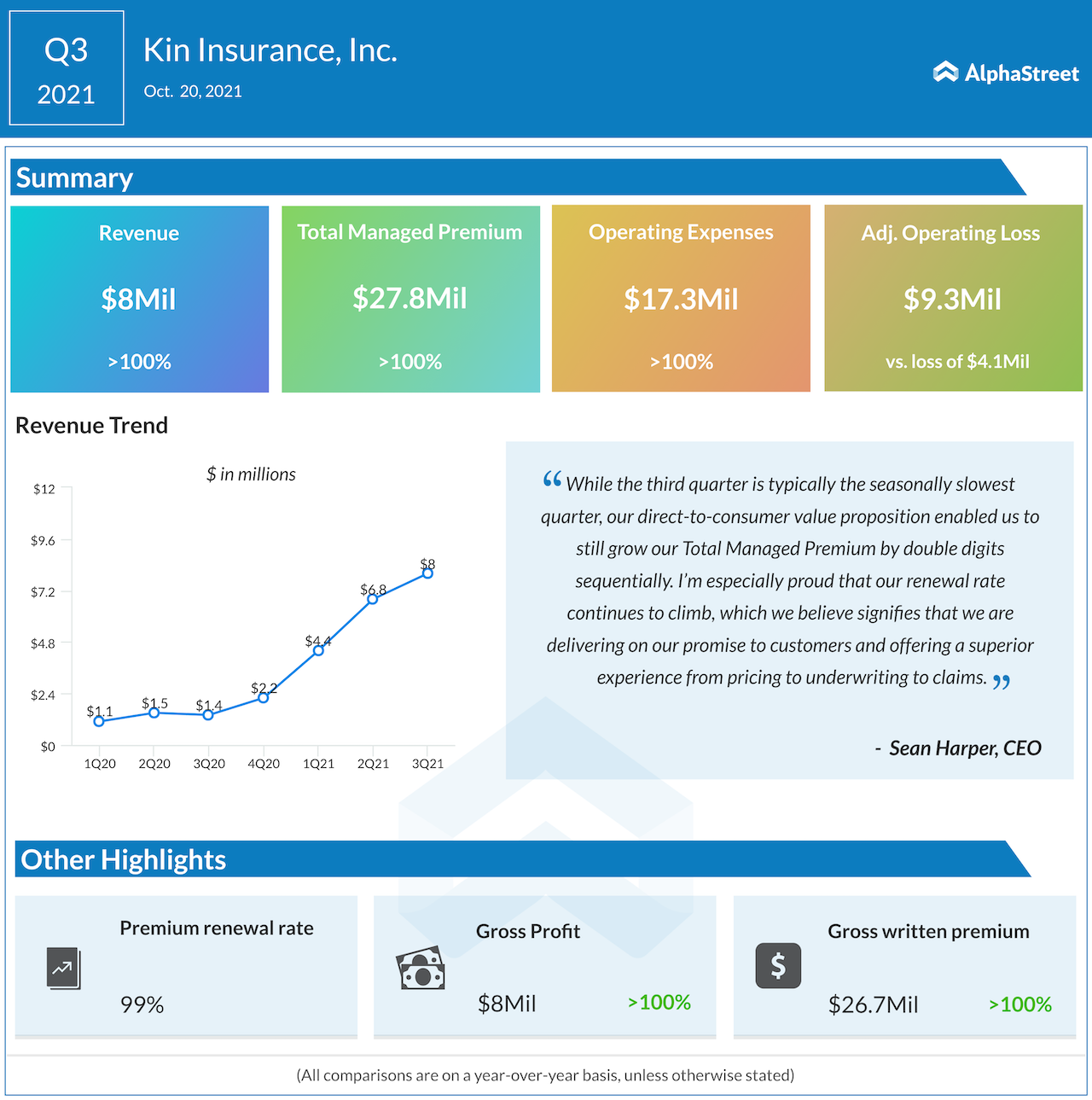Categories Finance, Interviews
Kin Insurance CEO Sean Harper: Will expand into new states, enhance portfolio
Kin Insurance, a provider of direct-to-consumer insurance solutions, has carved a niche for itself in the industry by making affordable home insurance accessible to customers. The Chicago-based company, which is currently expanding into new markets, is also preparing to go public. In an interview with AlphaStreet, Sean Harper, chief executive officer of the insurtech company, spoke about the business, growth strategy, and the SPAC merger.

What factors drove the 420% increase in managed premium in Q3, despite being a cyclically slow quarter? Should investors expect a similar trend in the upcoming quarters?
While the third quarter is typically the seasonally slowest quarter, Kin’s direct-to-consumer value proposition enabled us to still grow our Total Managed Premium by double digits sequentially. We’ve built a company that enables us to acquire new customers efficiently, and this past quarter we invested more into it. Kin’s renewal rate on the carrier also increased to a record 99%.
We expect to experience a similar trend in the upcoming quarters because we have been adamant about not scaling this business prematurely. Our focus continues to be on making sure the math around our customer acquisition works really well and renews at a high rate.

How do you manage risks and fraudulent claims when you do away with all the traditional documentations?
Reducing fraud and the risk that comes with it is imperative in our business. For example, the industry has been plagued by a type of fraud called Assignment of Benefits, which involves an agreement that transfers insurance claims rights to another party — usually a contractor. They take advantage of the agreement and inflate repairs and costs or bill for work that was never completed, which can hurt policyholders.
That’s why we created the Responsible Repair Discount, which rewards homeowners who decline to hand over their claim benefits to a vendor. We also offer a Managed Repair Program to connect our policyholders with a trustworthy licensed, insured, local contractor to handle repairs so they don’t have to vet professionals.
We rely on traditional documentation of losses – but we believe we acquire that documentation in a more strategic manner. For example, customers can get the claims process started via our website or by phone, email, or text. After a major disaster like Hurricane Ida, we also leverage aerial imagery to assess the damage, oftentimes before evacuated policyholders even return home.
ALSO READ Wellteq CEO Scott Montgomery: Our platform aimed at coaching people towards better health habit
What’s your customer growth trend and churn rate? And how is the general customer demographics?
Kin’s average customer age is 57, which is unique for a direct-to-consumer brand – many DTC businesses cater to younger customers. Kin’s customers have relatively high spending power, are embracing technology, and often recommend businesses they love to their friends and family. We believe these demographics provide us with a wealth of future cross-sell opportunities for existing and new customers. Last quarter, Kin had only a 1% churn rate, which is lower than our peers in the market.
What is going to be your focus over the next two years?
Our most important priority is to grow. We intend to grow a lot in the states where we currently operate, which are a $20 billion market in aggregate. We also plan to grow into new states; we anticipate we will launch enough new states next year that our TAM will be $50 billion. We are also focused on product innovation.

Why choose the SPAC route for public listing?
Our unit economics are very strong – our LTV (lifetime value of a customer) to CAC (customer acquisition cost) ratio is 7.9x, driven by our high premium-per-customer and by our low churn rate. Because our unit economics are so strong and predictable, we are in a good position to go public through the business combination with the SPAC and to use the proceeds of the transaction to fund our growth plan and continue to scale. We chose the SPAC route mainly because the SPAC we are merging with is strategic and able to help us progress the business in a variety of ways.
Overall, we chose to go public because it’s our mission to create a solution at the intersection of climate change and technology that disrupts the 100+-year-old insurance industry. By going public, we’re able to bring our solution to more homeowners.
ALSO READ Resonate Blends CIO David Thielen: Spent the last 18 months cleaning up our balance sheet
Did Covid have an impact on your business?
We moved our operations entirely online in March 2020. Unlike most insurance companies, we are a digitally-native business and were able to keep operating without major disruption. The nature of our business is that people need home insurance, pandemic or not, so we’ve been able to not only retain all our staff during COVID-19 but also to grow our team. Looking ahead, we intend to continue hiring the best and brightest talent to help elevate our data-centric insurance solutions that address the needs of today’s world.
________
COVID-19 puts insurers in tricky situation; risks range from litigation to insolvency
Ravaging almost every part of the world and crippling economic activity, the coronavirus pandemic has not spared any business. When it comes to the insurance industry, the nature of impact is complex and there is no doubt the companies will struggle with their underwriting decisions once the damage is fully assessed.
Most Popular
DRI Earnings: Darden Restaurants’ Q2 2026 sales and profit rise YoY
Darden Restaurants, Inc. (NYSE: DRI), a leading fine dining restaurant chain, on Thursday reported an increase in sales and adjusted earnings for the second quarter of fiscal 2026. Total sales
CarMax (KMX) Q3 2026 earnings drop on lower sales; results beat estimates
Used car retailer CarMax, Inc. (NYSE: KMX) on Thursday reported a decline in earnings for the third quarter of fiscal 2026, hurt by lower sales. However, both revenues and earnings
ACN Earnings: Key quarterly highlights from Accenture’s Q1 2026 financial results
Accenture (NYSE: ACN) reported its first quarter 2026 earnings results today. Revenues of $18.7 billion increased 6% in US dollars and 5% in local currency compared to the same period a